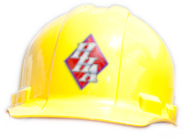When your heating and air duct, or equipment, is installed inside the crawl space, the temperature of the air is being delivered. The duct work is around 45 to 55 degrees. When that mixes with the warm (100% +) humid air, then, condensation is the end result. Some homes have drainage issues or rain water run-offs that go under the foundation walls, and the moisture starts to mix with warm humid air. Either way, it results in mildew growing in the crawl space - which will result in heavy molding if nothing is done to stop the issue.
To correct the issue, you have to do 3 very important things:
Install a Moisture Barrier
Installing a plastic moisture barrier (minimum of 6 mil. thickness) will lay on the ground. First, you need to clean any debris from the crawl space. Then, lay the material down on the surface. Roll the plastic up the wall 12”. Also, cut around each foundation pier. Roll the plastic up 12”, as well. Then, foam the plastic to the walls and piers to keep moisture from seeping up the moisture barrier.
Install a WHOLE House Dehumidifier
We used to tell our customers to go to your favorite big box store and purchase a 65-pint dehumidifier (a window unit). Now to our knowledge, they unfortunately break a lot. So, now we rely on a Honeywell DR65. This is a whole house machine that goes in the crawl space and suspends from the floor joist. We duct the system to each end of the crawl space to warm and dry up the moist areas. We install an independent drain line either in the sewer line or outside away from the foundation.
Seal Your Duct Work
Once you have completed steps 1 and 2, then you are ready to seal your duct work. There are two rules for doing this. You can seal the duct work by removing the duct wrap insulation and painting the seams with a liquid mastic. Then, install new duct wrap insulation around each duct. Some customers decide to replace the entire duct system and seal it completely while installing the new duct work.
For more information, you can reach me at kevin@harbinair.com.



